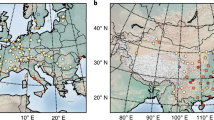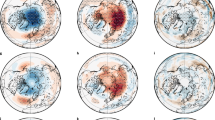Abstract
Solar variability can influence surface climate, for example by affecting the mid-to-high-latitude surface pressure gradient associated with the North Atlantic Oscillation1. One key mechanism behind such an influence is the absorption of solar ultraviolet (UV) radiation by ozone in the tropical stratosphere, a process that modifies temperature and wind patterns and hence wave propagation and atmospheric circulation2,3,4,5. The amplitude of UV variability is uncertain, yet it directly affects the magnitude of the climate response6: observations from the SOlar Radiation and Climate Experiment (SORCE) satellite7 show broadband changes up to three times larger than previous measurements8,9. Here we present estimates of the stratospheric ozone variability during the solar cycle. Specifically, we estimate the photolytic response of stratospheric ozone to changes in spectral solar irradiance by calculating the difference between a reference chemistry–climate model simulation of ozone variability driven only by transport (with no changes in solar irradiance) and observations of ozone concentrations. Subtracting the reference from simulations with time-varying irradiance, we can evaluate different data sets of measured and modelled spectral irradiance. We find that at altitudes above pressure levels of 5 hPa, the ozone response to solar variability simulated using the SORCE spectral solar irradiance data are inconsistent with the observations.
This is a preview of subscription content, access via your institution
Access options
Subscribe to this journal
Receive 12 print issues and online access
$259.00 per year
only $21.58 per issue
Buy this article
- Purchase on Springer Link
- Instant access to full article PDF
Prices may be subject to local taxes which are calculated during checkout




Similar content being viewed by others
References
Gray, L. J. et al. A lagged response to the 11 year solar cycle in observed winter Atlantic/European weather patterns. J. Geophys. Res. 118, 13405–13420 (2013).
Haigh, J. The impact of solar variability on climate. Science 272, 981–984 (1996).
Kodera, K. & Kuroda, Y. Dynamical response to the solar cycle. J. Geophys. Res. 107, 4749 (2002).
Simpson, I. R., Blackburn, J. D. & Haigh, M. The role of eddies in driving the tropospheric response to stratospheric heating perturbations. J. Atmos. Sci. 66, 1347–1365 (2009).
Gray, L. J. et al. Solar influences on climate. Rev. Geophys. 48, 4001 (2010).
Ineson, S. et al. Solar forcing of winter climate variability in the Northern Hemisphere. Nature Geosci. 4, 753–757 (2011).
Rottman, G. The SORCE mission. Sol. Phys. 230, 7–25 (2005).
Ball, W. T., Krivova, N. A., Unruh, Y. C., Haigh, J. D. & Solanki, S. K. A new SATIRE-S spectral solar irradiance reconstruction for solar cycles 21–23 and its implications for stratospheric ozone. J. Atmos. Sci. 71, 4086–4101 (2014).
Ball, W. T., Mortlock, D. J., Egerton, J. S. & Haigh, J. D. Assessing the relationship between spectral solar irradiance and stratospheric ozone using Bayesian inference. J. Space Weath. Space Clim. 4, A25 (2014).
Ermolli, I. et al. Recent variability of the solar spectral irradiance and its impact on climate modelling. Atmos. Chem. Phys. 13, 3945–3977 (2013).
McClintock, W. E., Rottman, G. J. & Woods, T. N. SOLar-STellar Irradiance Comparison Experiment II (SOLSTICE II): instrument concept and design. Sol. Phys. 230, 225–258 (2005).
Harder, J. W., Fontenla, J. M., Pilewskie, P., Richard, E. C. & Woods, T. N. Trends in solar spectral irradiance variability in the visible and infrared. Geophys. Res. Lett. 36, 7801 (2009).
Ball, W. T., Unruh, Y. C., Krivova, N. A., Solanki, S. & Harder, J. W. Solar irradiance variability: a six-year comparison between SORCE observations and the SATIRE model. Astron. Astrophys. 530, A71 (2011).
Lean, J. L. et al. How does the Sun’s spectrum vary? J. Clim. 25, 2555–2560 (2012).
Fröhlich, C. Evidence of a long-term trend in total solar irradiance. Astron. Astrophys. 501, L27–L30 (2009).
Lockwood, M. Reconstruction and prediction of variations in the open solar magnetic flux and interplanetary conditions. Living Rev. Sol. Phys. 10, 4 (2013).
Usoskin, I. G., Solanki, S. K. & Kovaltsov, G. A. in IAU Symposium (eds Mandrini, C. H. & Webb, D. F.) Vol. 286, 372–382 (IAU Symposium, 2012).
Fontenla, J. M., Curdt, W., Haberreiter, M., Harder, J. & Tian, H. Semiempirical models of the solar atmosphere. III. Set of non-LTE models for far-ultraviolet/extreme-ultraviolet irradiance computation. Astrophys. J. 707, 482–502 (2009).
Yeo, K. L., Krivova, N. A., Solanki, S. K. & Glassmeier, K. H. Reconstruction of total and spectral solar irradiance from 1974 to 2013 based on KPVT, SoHO/MDI, and SDO/HMI observations. Astron. Astrophys. 570, A85 (2014).
Austin, J. et al. Coupled chemistry climate model simulations of the solar cycle in ozone and temperature. J. Geophys. Res. 113, 11306 (2008).
Haigh, J. D., Winning, A. R., Toumi, R. & Harder, J. W. An influence of solar spectral variations on radiative forcing of climate. Nature 467, 696–699 (2010).
Merkel, A. W. et al. The impact of solar spectral irradiance variability on middle atmospheric ozone. Geophys. Res. Lett. 38, 13802 (2011).
Hood, L. L. et al. Solar signals in CMIP-5 simulations: the ozone response. Q. J. R. Meteorol. Soc. 141, 2670–2689 (2015).
Chiodo, G., Marsh, D. R., Garcia-Herrera, R., Calvo, N. & García, J. A. On the detection of the solar signal in the tropical stratosphere. Atmos. Chem. Phys. 14, 5251–5269 (2014).
Abalos, M., Legras, B., Ploeger, F. & Randel, W. J. Evaluating the advective Brewer–Dobson circulation in three reanalyses for the period 1979–2012. J. Geophys. Res. 120, 7534–7554 (2015).
Zubov, V., Rozanov, E., Egorova, T., Karol, I. & Schmutz, W. Role of external factors in the evolution of the ozone layer and stratospheric circulation in 21st century. Atmos. Chem. Phys. 13, 4697–4706 (2013).
Tummon, F. et al. Intercomparison of vertically resolved merged satellite ozone data sets: interannual variability and long-term trends. Atmos. Chem. Phys. Discuss. 14, 25687–25745 (2014).
Froidevaux, L. et al. Global OZone Chemistry And Related Datasets for the Stratosphere (GOZCARDS): methodology and sample results with a focus on HCl, H2O, and O3 . Atmos. Chem. Phys. Discuss. 15, 5849–5957 (2015).
McPeters, R. D., Bhartia, P. K., Haffner, D., Labow, G. J. & Flynn, L. The version 8.6 SBUV ozone data record: an overview. J. Geophys. Res. 118, 8032–8039 (2013).
Ineson, S. et al. Regional climate impacts of a possible future grand solar minimum. Nature Commun. 6, 7535 (2015).
Floyd, L. E., Cook, J. W., Herring, L. C. & Crane, P. C. SUSIM’S 11-year observational record of the solar UV irradiance. Adv. Space Res. 31, 2111–2120 (2003).
Yeo, K. L. et al. UV solar irradiance in observations and the NRLSSI and SATIRE-S models. J. Geophys. Res. 120, 6055–6070 (2015).
Lean, J., Rottman, G., Harder, J. & Kopp, G. SORCE contributions to new understanding of global change and solar variability. J. Sol. Phys. 230, 27–53 (2005).
Morrill, J. S., Floyd, L. & McMullin, D. Comparison of solar UV spectral irradiance from SUSIM and SORCE. Sol. Phys. 289, 3641–3661 (2014).
Stenke, A. et al. The SOCOL version 3.0 chemistry–climate model: description, evaluation, and implications from an advanced transport algorithm. Geosci. Model Dev. 6, 1407–1427 (2013).
Eyring, V. et al. Overview of IGAC/SPARC chemistry–climate model initiative (CCMI) community simulations in support of upcoming ozone and climate assessments. SPARC Newsl. 40, 48–66 (2013).
Dee, D. P. et al. The ERA-Interim reanalysis: configuration and performance of the data assimilation system. Q. J. R. Meteorol. Soc. 137, 553–597 (2011).
Kuchar, A., Sacha, P., Miksovsky, J. & Pisoft, P. The 11-year solar cycle in current reanalyses: a (non)linear attribution study of the middle atmosphere. Atmos. Chem. Phys. 15, 6879–6895 (2015).
Sato, M., Hansen, J. E., McCormick, M. P. & Pollack, J. B. Stratospheric aerosol optical depths, 1850–1990. J. Geophys. Res. 98, 22987–22994 (1993).
The Climate Data Guide: Multivariate ENSO Index (NCAR, 2013); https://climatedataguide.ucar.edu/climate-data/multivariate-enso-index.
Efron, B. & Tibshirani, R. J. An Introduction to the Bootstrap (CRC Press, 1994).
Acknowledgements
W.T.B. was funded by the SNSF projects 149182 (SILA) and 163206 (SIMA). We thank A. Stenke and A. Coulon for their advice, comments and help with the model nudging. We thank M. Snow for his comments on SORCE/SOLSTICE. We thank the GOZCARDS, SWOOSH and SBUV teams for their ozone products. E.V.R. was partially supported by the Swiss National Science Foundation under grant agreement CRSII2-147659 (FUPSOL II). T.S. was funded by SNSF project 153302.
Author information
Authors and Affiliations
Contributions
W.T.B. prepared the solar data, performed the model experiments, carried out the linear analysis and interpretation of results. W.T.B. and J.D.H. wrote the paper. W.T.B., T.S. and E.V.R. designed and set up the model simulations, F.T. provided the ozone data sets and advice on their use, A.V.S. prepared the CCM model nudging and A.K. performed the MLR analysis. J.D.H., E.V.R. and W.S. provided expert advice and discussion on the results.
Corresponding author
Ethics declarations
Competing interests
The authors declare no competing financial interests.
Supplementary information
Supplementary Information
Supplementary Information (PDF 693 kb)
Rights and permissions
About this article
Cite this article
Ball, W., Haigh, J., Rozanov, E. et al. High solar cycle spectral variations inconsistent with stratospheric ozone observations. Nature Geosci 9, 206–209 (2016). https://doi.org/10.1038/ngeo2640
Received:
Accepted:
Published:
Issue Date:
DOI: https://doi.org/10.1038/ngeo2640
This article is cited by
-
Segmentation of Coronal Features to Understand the Solar EUV and UV Irradiance Variability III. Inclusion and Analysis of Bright Points
Solar Physics (2021)
-
Role of Natural and Anthropogenic Loadings on Indian Temperature Trends
Pure and Applied Geophysics (2019)
-
Revision of the Sun’s Spectral Irradiance as Measured by SORCE SIM
Solar Physics (2018)
-
Aerosol and Solar Irradiance Effects on Decadal Climate Variability and Predictability
Current Climate Change Reports (2017)
-
Solar Spectral Irradiance at 782 nm as Measured by the SES Sensor Onboard Picard
Solar Physics (2016)



